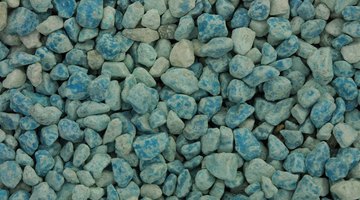Pea Gravel vs. Stone for a French Drain
French drains are the most common method used in the home landscape to direct water away from building foundations or other areas it is not wanted.

The concept is simple: a ditch is dug that travels downhill at a shallow angle away from the house, and water that collects where the drain begins will follow the drain to where it ends. Either stone or pea gravel, and sometimes both, are used in the constuction of a French drain, depending on the design preferences of the builder.
Using Pea Gravel
Modern French drains have perforated plastic piping as a significant part of the design: A ditch is dug, protected piping laid in the ditch, and the pipe covered. Pea gravel is the most common medium for this design and offers a few advantages. It is usually smooth and less likely to puncture the piping and create eventual build-up; because of its small size a relatively smooth surface can be made atop the pea gravel with sod or another medium; it is also cheap and easy to move relative to some other options.
Using Stone
Traditionally French drains do not involve a pipe at all and a ditch is simply filled with coarse stone to allow water to flow through. This method is effective and larger stone is preferable as larger stones allow more space between each other for water to drain through. In the long run large stone may last longer than a pipe system, and is easier to repair if the drain becomes clogged. However, relative to modern French drains, these drains are sometimes considered unsightly or dangerous in landscapes, as the large stone drain must be left open. Covering this type of drain with dirt or sod will easily lead to clogging.
Using both Stone and Pea Gravel
Though more expensive, complicated, and time consuming, using both pea gravel and stone together is one of the best ways to form a French drain. Pea gravel is laid first, then your pipe. Being careful not to injure the pipe, drainlayers form a layer of larger stone on top of the pipe then finish with a layer of pea gravel. The large stone on the bottom helps give maximum drainage while the smaller pea gravel on top makes laying sod over the drain possible.
Considerations
If time and money are scarce, an old style French drain, with large stones, is probably best. Though the drain itself will remain visible in your yard, there are many ways to give the drain aesthetic appeal. All in all the process will be much quicker and significantly cheaper, though the right stone may be hard to find and the actual labor involved may be more strenuous. Pea gravel, on the other hand, is very easy to find in appropriate quantities, but the added complications of the pipe and sod can make this method seem more trouble than it's worth, unless you really want your drain to remain invisible.
The Drip Cap
- French drains are the most common method used in the home landscape to direct water away from building foundations or other areas it is not wanted.
- In the long run large stone may last longer than a pipe system, and is easier to repair if the drain becomes clogged.
- Pea gravel is laid first, then your pipe.
- The large stone on the bottom helps give maximum drainage while the smaller pea gravel on top makes laying sod over the drain possible.
References
Writer Bio
Ian Willson is a professional landscaper and certified master gardener in Louisiana. He graduated from Virginia Commonwealth University with a B.S. in sociology. Willson's work has been published in "Style Weekly," a local newspaper in Richmond, Va.
Photo Credits
- Photos.com/Photos.com/Getty Images
- Photos.com/Photos.com/Getty Images
More Articles



